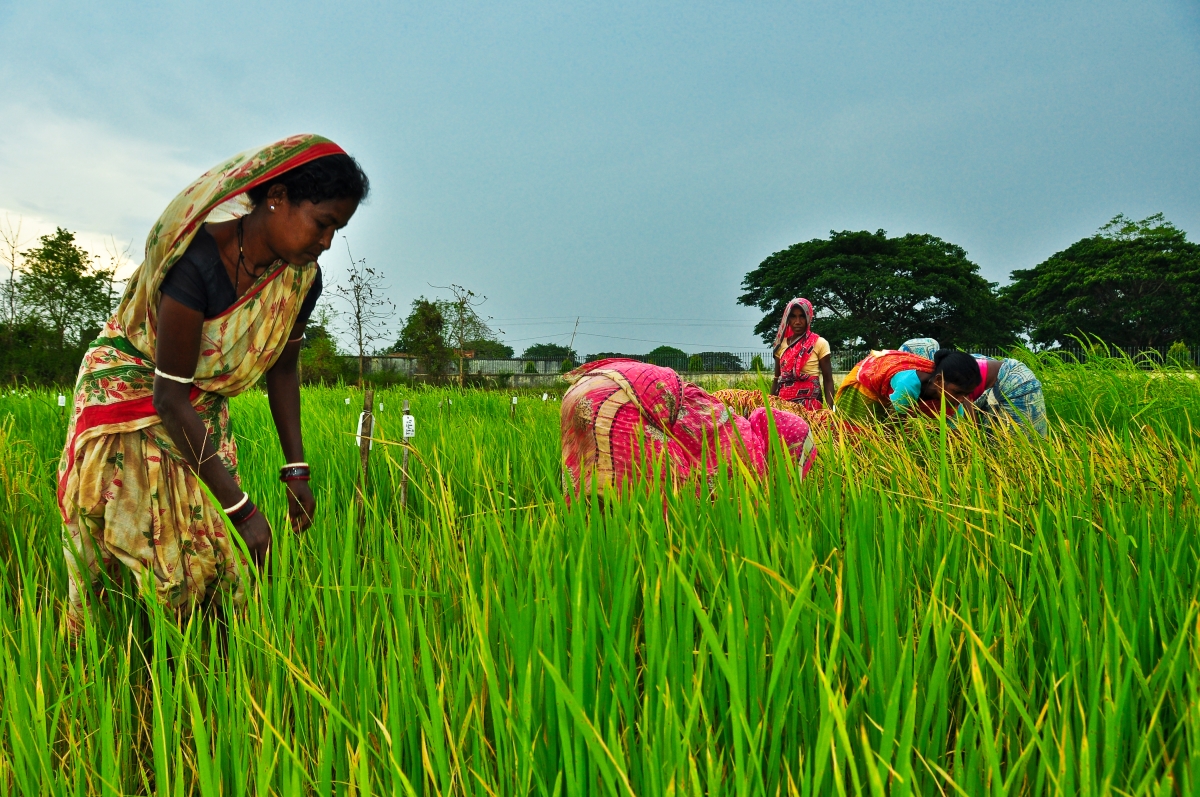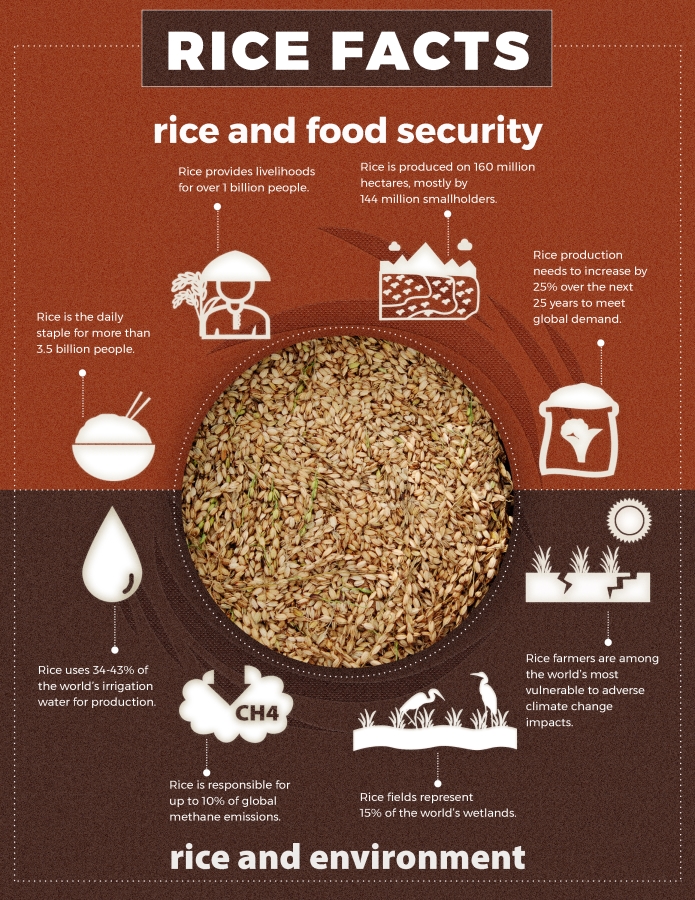Rice plays a crucial role in realizing the United Nations (UN) Sustainable Development Goal to end hunger, achieve food security and improved nutrition, and promote sustainable agriculture.

Rice is the world’s most important staple food for more than half of the planet’s population and will continue to be so in the coming decades. It provides up to a third of the calories in low- and middle-income countries. With expected population and income growth, the global demand for rice will continue to increase from 480 million tons of milled rice in 2015-16 to 536 to 551 million tons in 2030.
Because rice is such an important food crop, it also has a sizable ecological footprint: it is annually harvested from 157 million ha (8% of the world’s crop land), uses 27 million tons of fertilizer (15% of the world total), receives 440-550 km3 of irrigation water (34-43% of the world total), and accounts for 1.2% of all global greenhouse gas emissions. (See infographic below)
Rice farming is also associated with poverty. About 900 million of the world’s poor and undernourished people depend on rice as farmers, small millers, processors, traders, retailers, or consumers. Out of these, around 400 million are engaged in growing rice on 144 million smallholder farms.
With diminishing and threatened land, water, labor, and energy resources and the problems brought about by climate change, rice will have to be produced, processed, and marketed in more sustainable and environment-friendly ways. And, to help lift farmers and other supply-chain actors and consumers out of poverty, rice production and processing need to be profitable for its actors while the grain itself needs to remain affordable to consumers.
Hence, rice plays a crucial role in realizing the United Nations (UN) Sustainable Development Goal to end hunger, achieve food security and improved nutrition, and promote sustainable agriculture.

All data presented in this text are from the CGIAR Research Program on RICE, 2016
Globalization increasingly affects the world’s rice sector nationally and locally. Although the bulk of rice is still consumed domestically, the share of internationally traded rice increased from less than 4% before the mid-1990s to 7−8% by 2010. Other effects of globalization include the entry of the private sector into rice breeding, increasing interest in direct sourcing of rice by international food companies, expanding penetration of multinational input and service suppliers in national rice sectors, the increasing role of these companies as major providers of agronomic and management advice to farmers, and the formation of global multistakeholder platforms, such as the Sustainable Rice Platform (SRP), comprising the food industry, agri-businesses, academia, the public sector, and nongovernment organizations.
The SRP was created to improve the overall biophysical, environmental, and socio-economic sustainability of the global rice sector. Convened in 2011 by the UN Environment Programme and the International Rice Research Institute, it currently assembles 76 global, national, and local actors from academic, public, and private sectors along the whole rice value chain. It promotes resource efficiency and sustainability in the global rice sector through an alliance that links research, production, policymaking, trade, and consumption. The SRP pursues public policy development and voluntary market transformation initiatives to provide private, nonprofit, and public actors in the global rice sector with sustainable production standards and outreach mechanisms that contribute to a higher global supply of affordable rice, better livelihoods for rice producers, and a lower environmental impact of rice production. (See Finding the balance between the rice sector and the environment.)
In 2015, the SRP launched the world’s first international standard for sustainable rice. It sets new and more efficient standards for rice cultivation that allow any rice system to be assessed for its sustainability via 46 requirements under eight broad themes: farm management, pre-planting, water use, nutrient management, pest management, harvest and postharvest, health and safety, and labor rights. Progress toward compliance can be measured through a set of 12 quantitative performance indicators. Together, the SRP standard and indicators offer an objective “working definition” of sustainability that can serve as a basis for monitoring and evaluation, policymaking, as well as a benchmark for supply chain assurance schemes. After two years of field testing by the SRP and its partners, the standard and indicators are being evaluated and the rollout of version 2 is being prepared.
On 3-5 October, at the United Nations Convention Centre (UNCC) in Bangkok, the SRP will hold the First Global Sustainable Rice Conference and Exhibition 2017. It will bring together its members and dialogue partners to review the experiences with the standard and indicators and discuss collaborative approaches and innovative solutions to the critical sustainability challenges facing the rice sector.
This special issue of Rice Today features the Sustainable Rice Platform and the sustainable rice standard and indicators, and showcases some of the experiences obtained by its members and partners in the field. It also presents several research-based technologies that can help farmers improve sustainability in various dimensions while contributing to food security and poverty alleviation. The contributors to this special issue hope that readers, especially the participants in the conference and exhibition, become excited about these developments in the rice sector and join the efforts of the Sustainable Rice Platform!
__________________________
Dr. Bouman is the director of the CGIAR Research Program on rice agri-food systems (RICE).





